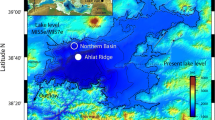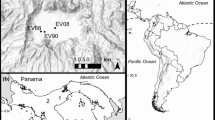Abstract
Fossil diatoms were analysed from a 10.3 m core from Harris Lake, Cypress Hills, Saskatchewan, and a diatom-salinity transfer function was used to construct a history of Holocene salinity changes for the lake. The diatom paleosalinity record indicates that Harris Lake remained fresh <0.5 g l-1 throughout the Holocene, with only slight increases in salinity between approximately 6500 and 5200 years BP. This interval corresponds to the only period in the lake's history when planktonic diatoms were abundant; benthic Fragilaria taxa, mainly F. pinnata, F. construens and F. brevistriata were dominant throughout most of the Holocene. The shift from a benthic to a planktonic diatom flora between 6500 and 5200 years BP may be an indirect response to a warmer climate that reduced forest cover in the watershed and allowed greater rates of inorganic sedimentation. The small salinity increase that accompanies the floristic change is probably not the result of lower lake levels; in fact the lake was probably deeper at this point than in the later Holocene. This paleosalinity record indicates that Harris Lake did not experience episodes of hypersalinity during the mid-Holocene, as suggested by a previous study, and that the lake may have been fresh during the early Holocene as well.
Similar content being viewed by others
References
Anderson, N. J., 1990. The biostratigraphy and taxonomy of small Stephanodiscusand Cyclostephanosspecies (Bacillariophyceae) in a eutrophic lake, and their ecological implications. Br. Phycol. J. 25: 217–235.
Bennion, H., 1994. A diatom-phosphorus transfer function for shallow, eutrophic ponds in southeast England. Hydrobiologia 275/276: 391-410.
Bennion, H., 1995. Surface-sediment diatom assemblages in shallow, artificial, enriched ponds, and implications for reconstructing trophic status. Diatom Research 10: 1–19.
Blinn, D. W., 1993. Diatom community structure along physicochemical gradients in saline lakes. Ecology 74: 1246–1263.
Cumming, B. F., S. E. Wilson, R. I. Hall & J. P. Smol, 1995. Diatoms from British Columbia (Canada) Lakes and Their Relationship to Salinity, Nutrients and Other Limnological Variables. Bibliotheca Diatomologica 31: 1–207.
Fritz, S. C., 1990. Twentieth-century salinity and water-level fluctuations in Devils Lake, North Dakota: Test of a diatom-based transfer function. Limnol. Oceanogr. 35: 1771–1781.
Fritz, S. C., S. Juggins & R. W. Battarbee, 1993a. Diatom assemblages and ionic characterization of freshwater and saline lakes of the northern Great Plains, North America: a tool for reconstructing past salinity and climate fluctuations. Can. J. Fish. aquat. Sci. 50: 1844–1856.
Fritz, S. C., J. C. Kingston & D. R. Engstrom, 1993b. Quantitative trophic reconstruction from sedimentary diatom assemblages: a cautionary tale. Freshwat. Biol. 30: 1–23.
Fritz, S. C., S. Juggins, R. W. Battarbee & D. R. Engstrom, 1991. Reconstruction of past changes in salinity and climate using a diatom-based transfer function. Nature 352: 706–708.
Gasse, F., J. F. Talling & P. Kilham, 1983. Diatom assemblages in East Africa: classification, distribution, and ecology. Revue Hydrobiol. trop. 16: 3–34.
Hickman, M., 1974. Effects of the discharge of thermal effluent from a power station on Lake Wabamun, Alberta, Canada–The epipelic and epipsammic algal communities. Hydrobiologia 45: 199–215.
Hickman, M. & C. E. Schweger, 1993. Late glacial-early holocene palaeosalinity in Alberta, Canada–climate implications. J. Paleolimnol. 8: 149–16.
Hickman, M. & J. M. White, 1989. Late Quaternary palaeoenvironment of Spring Lake, Alberta, Canada. J. Paleolimnol. 2: 305–317.
Hickman, M., C. E. Schweger & T. Habgood, 1984. Lake Wabamun, Alta.: a paleoenvironmental study. Can. J. Bot. 62: 1438–1465.
Laird, K. R., S. C. Fritz, E. C. Grimm & P. G. Mueller, in press. Century-scale paleoclimatic reconstruction from Moon Lake, a closed-basin lake in the northern Great Plains. Limnol. Oceanogr.
Last, W.M., 1989. Continental brines and evaporites of the northern Great Plains. Sed. Geol. 64: 207–221.
Last, W. M. & D. J. Sauchyn, 1993. Mineralogy and lithostratigraphy of Harris Lake, southwestern Saskatchewan, Canada. J. Paleolimnol. 9: 23–39.
Line, J. M., C. J. F. ter Braak & H. J. B. Birks, 1994. WACALIB version 3.3–a computer program to reconstruct environmental variables from fossil assemblages by weighted averaging and to derive sample-specific errors of prediction. J. Paleolimnol. 10: 147–152.
Megard, R. O., 1969. Algae and photosynthesis in Shagawa Lake Minnesota. Minnesota University Limnology Research Centre Interim Report No. 5.
Porter, S. C., 1993. A Reconstruction of Holocene Environments Based on Ostracodes, Harris Lake Watershed, Cypress Hills, Saskatchewan. MSc. thesis, Dept. of Geography, University of Regina, Saskatchewan.
Radle, N., C. M. Keister & R. W. Battarbee, 1989. Diatom, pollen, and geochemical evidence for the paleosalinity of Medicine Lake, S. Dakota, during the Late Wisconsin and early Holocene. J. Paleolimnol. 2: 159–172.
Reavie, E. D., R. I. Hall & J. P. Smol, 1995. An expanded weighted-averaging model for inferring past total phosphorus concentrations from diatom assemblages in eutrophic British Columbia (Canada) lakes. J. Paleolimnol. 14: 49–67.
Ritchie, J. C., 1985. Quaternary pollen records from the western interior and the arctic of Canada. In V. M. Bryant & R. G. Holloway (eds), Pollen records of late-Quaternary North American sediments. American Association of Stratigraphic Palynologists Foundation, Dallas, Texas, pp. 327–551.
Sandgren, C. D. & W. E. Walton, 1995. The influence of zooplankton herbivory on the biogeography of chrysophyte algae. In Sangren, C. D., Smol, J. P. & Kristiansen, J. (eds), Chrysophyte Algae: Ecology, Phylogeny and Development. Cambridge University Press, Cambridge, UK. pp. 269–302.
Sauchyn, D. J., 1990. A reconstruction of Holocene geomorphology and climate, western Cypress Hills, Alberta and Saskatchewan. Can. J. Earth Sci. 27: 1504–1510.
Sauchyn, D. J., 1993. Quaternary and late Tertiary landscape evolution in the western Cypress Hills. In Sauchyn, D. J. (ed.), Quaternary and Late Tertiary Landscape Evolution of Southwestern Saskatchewan and Adjacent Areas. Canadian Plains Research Center, Regina, Saskatchewan, pp. 46–58.
Sauchyn, M. A. & D. J. Sauchyn, 1991. A continuous record of Holocene pollen from Harris Lake, southwestern Saskatchewan, Canada. Palaeogeogr. Palaeoclimatol. Palaeoecol. 88: 13–23.
Smol, J. P., 1985. The ratio of diatom frustules to chrysophycean statospores: a useful paleolimnological index. Hydrobiologia 123: 199–208.
Smol, J. P., 1995. Application of chrysophytes to problems in paleoecology. In Sangren, C. D., Smol, J. P. & Kristiansen, J. (eds), Chrysophyte Algae: Ecology, Phylogeny and Development. Cambridge University Press, Cambridge, UK. pp. 303–329.
Stoermer, E. F., H. Håkansson & E. C. Theriot, 1987. Cyclostephanosspecies newly reported from North America: C. tholiformissp. nov. and C. costatilimbuscomb. nov. Br. phycol. J. 22: 349–358.
Vance, R. E., R. W. Mathewes & J. J. Clague, 1992. 7000 year record of lake-level change on the northern Great Plains: A high-resolution proxy of past climate. Geology 20: 879–882.
Vreeken, W. J., 1986. Quaternary events at the glacial drift border near Elkwater, southeastern Alberta. Can. J. Earth Sci. 23: 2024–2038.
Wilson, S. E., B. F. Cumming & J. P. Smol, 1994. Diatom-salinity relationships in 111 lakes from the Interior Plateau of British Columbia, Canada: the development of diatom-based models for paleosalinity reconstructions. J. Paleolimnol. 12: 197–221.
Wilson, S. E., B. F. Cumming & J. P. Smol, in press. Assessing the reliability of salinity inference models from diatom assemblages: An examination of a 219 lake dataset from western North America. Can. J. Fish. aquat. Sci.
Wright Jr., H. E., 1991. Coring tips. J. Paleolimnol. 6: 37–49.
Author information
Authors and Affiliations
Rights and permissions
About this article
Cite this article
Wilson, S.E., Smol, J.P. & Sauchyn, D.J. A Holocene paleosalinity diatom record from southwestern Saskatchewan, Canada: Harris Lake revisited. Journal of Paleolimnology 17, 23–31 (1997). https://doi.org/10.1023/A:1007956808240
Issue Date:
DOI: https://doi.org/10.1023/A:1007956808240




